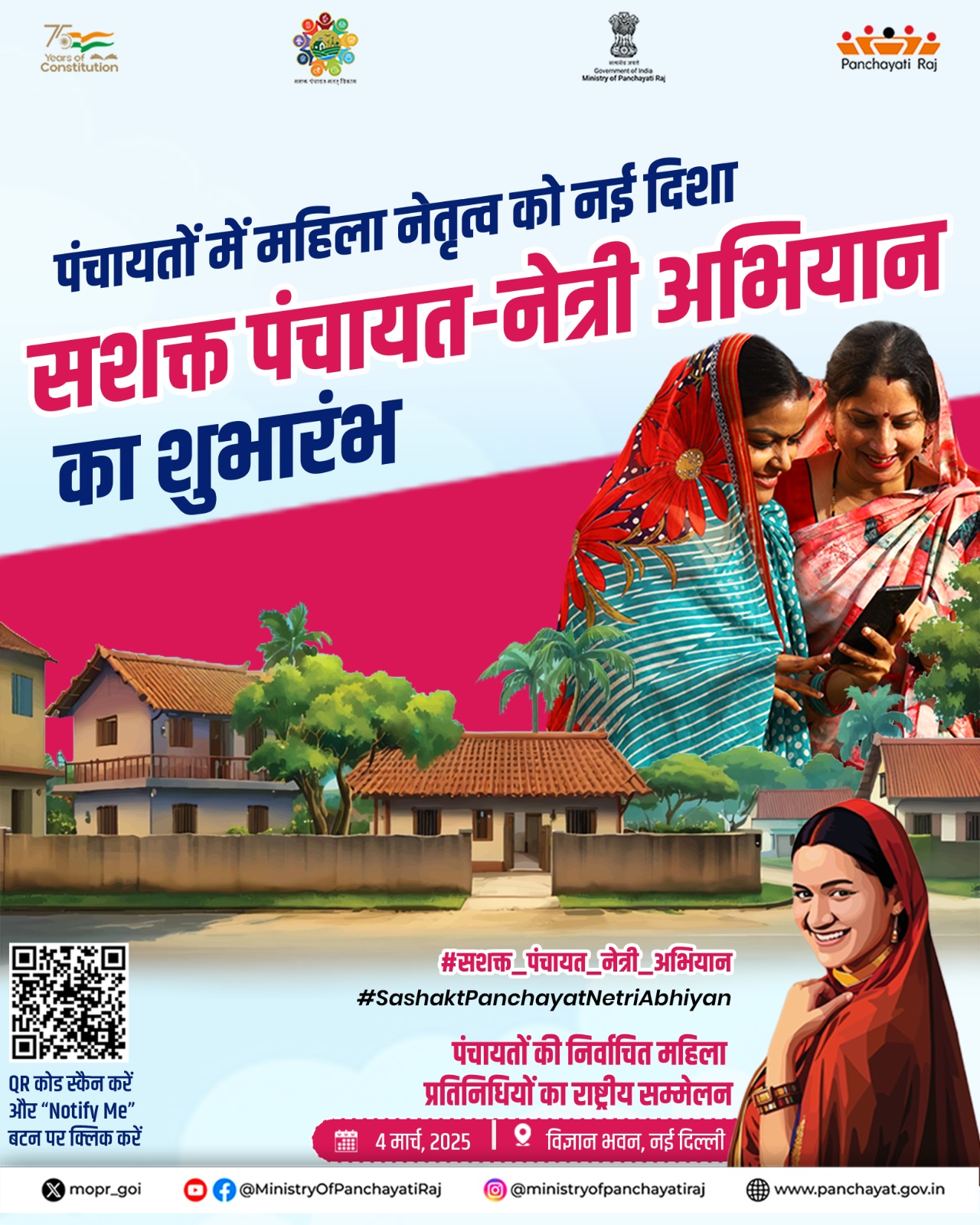Sashakt Panchayat-Netri Abhiyan

- 06 Mar 2025
In News:
The Ministry of Panchayati Raj launched the “Sashakt Panchayat-Netri Abhiyan” at a National Workshop held in Vigyan Bhawan, New Delhi. The initiative is a significant step toward gender-sensitive governance and enhancing the role of Women Elected Representatives (WERs) in Panchayati Raj Institutions (PRIs).
Key Features of the Initiative
- Objective: Capacity-building of WERs to strengthen their leadership, decision-making, and active participation in local governance.
- Scale: Over 1,200 WERs from across India participated.
- Representation: Women from all three tiers of PRIs took part, marking a first-of-its-kind national gathering.
Model Women-Friendly Gram Panchayats (MWFGPs)
- Launched alongside the Abhiyan.
- Aim: Establish at least one Model Women-Friendly Gram Panchayat in each district.
- Purpose: Promote gender-sensitive, inclusive, and girl-friendly local governance models.
Primer on Gender-Based Violence
- A "Primer on Law Addressing Gender-Based Violence and Harmful Practices" was released.
- Targeted at elected representatives to raise awareness and promote legal literacy regarding women's safety and rights.
Context and Background
- India has over 1.4 million women elected representatives in PRIs.
- Some states, like Bihar, report over 50% representation, surpassing the 33% constitutional mandate.
- The campaign also addresses the elimination of "Sarpanch Pati" culture, emphasizing the independent authority of WERs.
Panel Discussions and Sectoral Themes
- Themes included:
- Women’s participation and leadership in PRIs
- Health, education, safety, digital empowerment, and economic opportunities for women
Cultural Integration and Recognition
- Cultural performances by UNFPA celebrated women’s achievements.
- Outstanding WERs from various states/UTs were felicitated for contributions to rural governance.
Significance
- Aligns with PM Narendra Modi’s “Mann Ki Baat” (119th episode) highlighting Nari Shakti in nation-building.
- Reinforces commitment to inclusive, safe, and socially just Gram Panchayats.
UNICEF’s State of the World’s Children 2024 (SOWC-2024) Report
- 21 Nov 2024
In News:
The world is facing an unprecedented crisis with nearly half of all children – about 1 billion – living in countries that face a high risk of climate and environmental hazards, the UNICEF’s State of the World’s Children 2024 (SOWC-2024) report, said.
Key Highlights:
Environmental Hazards and Children’s Health:
- Children face an increasingly unpredictable and hazardous environment due to climate change, environmental crises, and frontier technologies.
- Nearly 1 billion children live in countries facing high risks from climate and environmental hazards.
- Children’s developing bodies are especially vulnerable to pollution, extreme weather, and environmental hazards.
- Air pollution, rising temperatures, and extreme weather events harm children's respiratory health, increase the spread of diseases like malaria and dengue, and impact food security and access.
Impact of Climate Change:
- Climate destabilization, biodiversity loss, and pollution are intensifying globally.
- Climate-related disasters (e.g., floods) affect water supplies, causing waterborne diseases, a leading cause of death in children under five.
- Extreme weather events, such as floods, can cause trauma, anxiety, and displacement for children.
- By the 2050s, more children will be exposed to extreme climate hazards compared to the 2000s.
- School closures, affecting 400 million children since 2022 due to extreme weather, disrupt education and hinder economic growth.
Projections for Child Survival and Life Expectancy:
- Newborn survival rates: Projected to rise by nearly 4 percentage points to over 98% globally by the 2050s.
- Probability of surviving to age 5: Expected to increase to 99.5%.
- Life expectancy: Expected to rise to 81 years for girls and 76 years for boys by the 2050s.
Child Population Trends by 2050:
- Global child population expected to stabilize at 2.3 billion by the 2050s.
- South Asia, Eastern/Southern Africa, and West/Central Africa will have the largest child populations, facing significant challenges in meeting children’s basic needs.
- These regions also face climate risks, inadequate digital infrastructure, and socio-economic challenges.
Technological Advancements:
- Artificial Intelligence (AI), neurotechnology, renewable energy, and vaccine breakthroughs could significantly improve childhood well-being.
- Digitalization: While it can empower children, it also exposes them to online risks, including sexual exploitation and abuse.
Socio-Economic Conditions and Inequality:
- 23% of children projected to live in low-income countries by 2050, a significant increase from 11% in the 2000s.
- GDP per capita in East Asia, Pacific, and South Asia expected to more than double from the 2020s to the 2050s.
- Growing inequalities between high- and low-income countries, particularly in terms of digital access and infrastructure.
Urbanization and Child Welfare:
- By the 2050s, nearly 60% of children globally will live in urban areas, up from 44% in the 2000s.
- Ensuring healthier and more secure urban environments is critical for improving future childhoods.
- Over 95% of people in high-income countries are connected to the internet, compared to just 26% in low-income countries, exacerbating inequalities.
Key Takeaways:
- Children are facing a more hazardous environment than ever before, influenced by climate change, technological developments, and demographic shifts.
- Proactive measures are needed to mitigate environmental risks, promote digital inclusion, and ensure equitable access to resources and opportunities for children globally.
